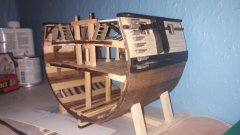
Bob Cleek
-
Posts
3,374 -
Joined
-
Last visited
Reputation Activity
-
 Bob Cleek reacted to Jaager in PVA glue as a sealant for wood
Bob Cleek reacted to Jaager in PVA glue as a sealant for wood
A primer of half saturated shellac is easily applied using a cotton rag - a worn out T shirt or bed sheet - it soaks into the wood. Using the rag - no ponds are left on the surface - it does not hide detail.
Indeed, if you had used an open pore wood species like Oak or Walnut, the open pores would still be there. The application is less involved than using an air brush. It is quick and simple to use. It takes many applications of full strength to build any sort of thickness - an application is just a wet layer, not a coat.
Use scrap wood and practice a few times - you will then realize that it is not as complicated as imagined. You can buff with a Scotch Brite pad when dry - 0000 steel wool is traditional, but the steel shards - not seen, but there - make themselves known when they turn to rust and leave a stain.
-
 Bob Cleek reacted to wefalck in PVA glue as a sealant for wood
Bob Cleek reacted to wefalck in PVA glue as a sealant for wood
The point of a wood sealer or sanding sealer is that it should penetrate into the wood. There are two properties that help this process, low viscosity and good wetting behaviour. These are properties that PVA doesn't really have, it has, if undiluted, a high viscosity and being 'polar' (sorry for the chemistry-speak), it is being repelled from more or less resinous wood. Good sanding sealers are based on some kind of organic solvent (which includes alcohol in the case of shellac) and quite thin, so it really soaks into the wood, rather than forming a layer on top.
A sealer has to be 'worked' into the wood - in the old days shellac was applied with a 'tampon'. Modern sanding sealers are usually applied with a bristle-brush. So, application by air-brush would be counterproductive.
-
 Bob Cleek got a reaction from mtaylor in Reputable online stores to find wood modeling supplies
Bob Cleek got a reaction from mtaylor in Reputable online stores to find wood modeling supplies
Yeah, it was a slow afternoon and I had time on my hands.
-
 Bob Cleek got a reaction from Terry Koch in Reputable online stores to find wood modeling supplies
Bob Cleek got a reaction from Terry Koch in Reputable online stores to find wood modeling supplies
Just some opinionated general observations to add to the good advice above, offered for what it's worth. Others' mileage may vary:
Since the internet and especially the Covid pandemic, we've begun living in the age of mail order. That has opened up much wider and more easily accessible sourcing options than we ever had before. However, the catch, particularly for those living outside of major metropolitan centers where a few "brick and mortal" shops struggle to survive, is that the costs of shipping and handling are added to online purchases and these added costs have risen exponentially in recent times. That fact has to be factored into the equation. "Amazon Prime" and "free shipping and handling" are significant considerations in making online purchases these days.
You can rely on any of this forum's sponsors for the best of whatever they sell. They've all been thoroughly vetted and their customer service is top notch. You won't go wrong looking to them for specialized ship modeling products and their prices are very reasonable. If I needed an airbrush, I wouldn't consider looking any further than USA Airbrush Supply or for after-market blocks any further than Syren Ship Models. This is a no-brainer for me.
If the online outfit advertises itself as a "hobby" anything, you are often better off going directly to an online supplier of professional supplies of the same type and see if you can do better. A "hobby shop" can get away selling lower quality tools and supplies at a higher price to a broader spectrum of customers, while a professional supply house will soon die on the vine if the professional customers aren't satisfied with product quality and service. Approach hobby outfits like Model Expo and Micro-Mark with caution. These two online retailers have an excellent selection of products for the modeler, but in many instances they are priced significantly higher than other sources catering to professional clients in allied fields. (It's a good idea to get on their mailing lists, though, because they often offer great discounts on clearance items.) This is particularly true with respect to tools. For example, Micro-Mark sells a pair of crudely scaled six-inch proportional dividers made by Tacro for $140.00, but you can find models of the finest rack-and-pinion adjustable, Verniier decimally-scaled ten-inch proportional dividers ever made, used and in good shape, for half that price or a higher-quality set of seven-inch dividers than the Tacro six-inchers for as little as $25 on eBay. The same goes for surgical and dental instruments. The "hobby shops" sell poor-quality tweezers, forceps, scissors, hemostats, scalpels and blades, and so on at higher prices than the mid-range quality stuff the medical and dental supply houses are offering on eBay or Amazon.
There is a wealth of model-building tools and materials that can be found in higher quality and lower prices from professional jewelers' supply houses. This is where to look for pliers, cutting tools, files, tweezers, rotary tools and burrs, soldering supplies, and such. A couple of the most popular are Rio Grande (https://www.riogrande.com/) and Otto Frei. (https://www.ottofrei.com/ ) Cheaper files can be had from hobby supply houses, but, for example, cheap files are a waste of money. The same goes for pliers and cutters. When buying tools, the cheapest quickly becomes the most expensive when you have to buy another to replace it.
Medical and dental supply houses are also a great source for ship modeling tools, although many of these companies sell "to the trade only" or in large lots to institutional purchasers. eBay is a good place to find used medical instruments useful in ship modeling, but caution has to be exercised because there are a lot of Asian manufacturers unloading poor-quality instruments on eBay. The upside of this is that they are often so inexpensive that taking a chance is worth the gamble. Carnegie Surgical Co. sells a range of professional quality ear polypuses, a type of forceps for working in very confined spaces that I consider to be an invaluable rigging instrument) ranging in price from around $100 to $250. Micro-Mark sells a 12" ear polypus for fifty bucks. eBay, on the other hand, has tons of different versions ranging from ten to twenty-five bucks (and up) that are quite acceptable for modeling use because we aren't going to be using them deep inside a patient's ear canal. The same applies to tweezers. If you're looking for an 8" or 12" pair of tweezers to reach inside the shrouds on your square-rigger, eBay is the place to buy them.
As a footnote, there was once a time when you could get lots of used medical and dental instruments from friendly medical professionals. Forty years ago, I worked in a large state institution that had a big dental clinic and I was friends with the chief dentist there who was an avid HO train modeler. He kept me supplied with all sorts of worn-out instruments: probes, dental chisels, drill burrs, forceps, pliers, and the like. (I still have an oddly shaped pair of pliers designed to extract molars which comes in handy now and again.) Sadly, a combination of the trend to disposable instruments which are more cost effective because autoclave sterilizing and sterile repackaging labor is no longer needed and heightened "biohazard" prevention protocols now mandate the controlled disposal of used instruments. Few doctors and dentists consider it appropriate to deviate from the biohazard disposal protocols and save a "goody box" of used instruments for their modeling friends. If you are lucky enough to find one who will still provide you with some, go for it!
Finally a word about paint. Ship modeling very rarely requires exact color matches. What we do need is quality paint with good archival qualities and a high content of good pigment ground finely that will produce good opacity. Most all the pre-mixed modeling paints marketed as such will meet these requirements... at a very high price. Bottled modeling paints are very convenient if one needs to get an exact color match and for this reason they are the favorites of armor, aircraft, and railroad modelers who need the exact shade of field gray used by the Wehrmacht in early 1943 or the exact shade of boxcar blue Conrail paints its boxcars. Ship modelers don't have the problem of that level of color accuracy and I don't think we have to pay five bucks an ounce and another five bucks in shipping and handling for a bottle of generic black, white, or bottom paint brown (which is the same as "boxcar red.") So I'd urge anybody who doesn't want to go broke collecting a couple of hundred one ounce bottles of modeling paint to display on their shop shelf while the paint dries hard in the bottles to learn to mix, condition and use quality tubed artists' oils or acrylics. Tubed colors have a shelf-life measured in decades, come in as many pre-mixed colors as anybody could possibly want, and, if one learns to mix their own colors, can provide any color in the rainbow out of five or seven tubes. (Black, white, red, blue, yellow, and for convenience maybe a brown, and a green.) There are many YouTube videos on how to use artists' tubed colors in both oil and acrylic for brush and airbrush application in miniature work which are well worth a ship modeler's time to watch. (Many are by the guys who paint fantasy gaming figures and miniature soldiers.) There is also an excellent instructional chapter on mixing your own colors for painting ship models in volume two of Ship Modeler's Shop Notes which can be purchased from the NRG. Tubed colors, as well as varnishes, thinners, and flattening (matte) additives and coatings are available on line from artists' supply houses, or locally from arts and crafts stores much easier than modeling paint is locally available at local hobby shops if you can even find one anymore. Painting and finishing ship models seems to be an aspect of the craft which is often given short shrift yet it is one of the most important factors in the final appearance of a model. There's a lot more to it than just applying paint straight out of the bottle. Once the relatively simple skill of mixing your own paint is mastered, you're free from all the limitations and inconveniences of sourcing pre-mixed modeling paint and can enjoy the benefit of saving lots of money over the course of a modeling career.
-
 Bob Cleek got a reaction from FriedClams in SMS WESPE 1876 by wefalck – FINISHED - 1/160 scale - Armored Gunboat of the Imperial German Navy - as first commissioned
Bob Cleek got a reaction from FriedClams in SMS WESPE 1876 by wefalck – FINISHED - 1/160 scale - Armored Gunboat of the Imperial German Navy - as first commissioned
Beautiful work! I think you are channeling Donald McNarry's ghost!
-
 Bob Cleek reacted to rwiederrich in Question on sail furling as it pertains to the position of the blocks.
Bob Cleek reacted to rwiederrich in Question on sail furling as it pertains to the position of the blocks.
3D....I tackled the issue by noting that the bunt line blocks are movable on the jackstay and can be rotated to the back of the stay and thus the furled sail. The sail then can be tightly furled with the blocks nicely stowed behind it. I wanted my Glory of the Seas to mimic actual practice. ON the yard not in front of it.
Check out my log for Glory of the Seas to see what I did to answer the call.
Good luck.
Rob
-
 Bob Cleek got a reaction from Canute in Wood filler recommendations
Bob Cleek got a reaction from Canute in Wood filler recommendations
No kidding! Don'tcha just hate waking up in a cold sweat dreaming about that "rare, but life-threatening infection in the skin of the perineum?"
-
 Bob Cleek got a reaction from Canute in Wood filler recommendations
Bob Cleek got a reaction from Canute in Wood filler recommendations
Recognizing that I may be sticking my neck out here, I'll offer the comment that the warnings seen on many solvent-based materials these days exist more for the manufacturer's' protection against products liability lawsuits which often result from the misuse of the product than for the protection of folks who use the product "as directed for the use intended." If you read the warnings now printed on a common ladder, you'd never climb one again. This phenomenon has created a certain level of paranoia in the general public, many of whom shy away from anything that has an odor they've been conditioned to find disagreeable. While chemistry continues to make progress in developing non-solvent-based materials, in most instances these substitute "water-based" materials intended to replace long-established solvent-based materials are inferior to their solvent-based predecessors, particularly with respect to their archival qualities, an important consideration in modeling. When used as directed, meaning "in a well-ventilated workspace" and in the small amounts encountered in modeling, there is generally negligible risk in using solvent-based materials. Commonsense is the order of the day in this respect. Without question, pouring an excessive amount of solvent-based material in a paper bag and "huffing" it is hazardous to your health, but we aren't contemplating that sort of misuse. Sadly, the general public's conditioned reaction to these product warnings has reduced the marketability of valuable materials and chased many manufacturers out of the marketplace entirely. (The demise of Floquil paints being a prime example.) In jurisdictions like California, which requires warning labels on anything that "may cause cancer or birth defects," we find state-mandated warning labels to that effect on everything from gasoline to wine and many long-valued solvent-based products can no longer be legally purchased at all. Local "product safety" ordinances in some California "air quality districts" even go so far as to outlaw the sale of any volatile organic compounds above a certain content limit including simple oil-based enamel paint or paint thinner and the like and, consequently, all that can be purchased anymore are inferior water-based coatings. Mindfulness of shop safety is a good thing, but we should not "throw the baby out with the bath water." Otherwise, we will continue to find valuable materials becoming entirely unavailable to the detriment of our craft.
That said, Bondo is a hygroscopic material intended for use on dented automotive body metal and is not intended for nor suitable for use on wooden surfaces.
-
 Bob Cleek reacted to rshousha in Value-for-Money Airbrush
Bob Cleek reacted to rshousha in Value-for-Money Airbrush
Our industry is very small, whether buyers, sellers, or manufacturers. If we want to encourage some small manufacturers to invest in machinery to make products locally, we have to lead by example, and buy locally-made products. Otherwise, if we are always looking for the cheapest solution, manufacturers will have little incentive to invest, create jobs, innovate, and feed our industry.
-
 Bob Cleek reacted to kurtvd19 in Value-for-Money Airbrush
Bob Cleek reacted to kurtvd19 in Value-for-Money Airbrush
Harry:
I one buys a brand name there isn't a need to find a source of parts.
Kurt
-
 Bob Cleek got a reaction from rshousha in Value-for-Money Airbrush
Bob Cleek got a reaction from rshousha in Value-for-Money Airbrush
Kurt's comments are worth a "sticky."
We are vigilant when it comes to pirated model kits, but piracy doesn't end with model kits. One of the "most-pirated" aspects of modeling are the tools we use.
-
 Bob Cleek got a reaction from BETAQDAVE in Split ring making process
Bob Cleek got a reaction from BETAQDAVE in Split ring making process
You forget the last three ring making steps:
Drop the completed ring on the floor.
Spend fifteen minutes looking for it while talking dirty before giving up.
Repeat.
-
 Bob Cleek got a reaction from mtaylor in SMS WESPE 1876 by wefalck – FINISHED - 1/160 scale - Armored Gunboat of the Imperial German Navy - as first commissioned
Bob Cleek got a reaction from mtaylor in SMS WESPE 1876 by wefalck – FINISHED - 1/160 scale - Armored Gunboat of the Imperial German Navy - as first commissioned
Beautiful work! I think you are channeling Donald McNarry's ghost!
-
 Bob Cleek got a reaction from Keith Black in SMS WESPE 1876 by wefalck – FINISHED - 1/160 scale - Armored Gunboat of the Imperial German Navy - as first commissioned
Bob Cleek got a reaction from Keith Black in SMS WESPE 1876 by wefalck – FINISHED - 1/160 scale - Armored Gunboat of the Imperial German Navy - as first commissioned
Beautiful work! I think you are channeling Donald McNarry's ghost!
-
 Bob Cleek reacted to Snug Harbor Johnny in Split ring making process
Bob Cleek reacted to Snug Harbor Johnny in Split ring making process
'Gosh - I forgot about how I used to make rings for chain mail ... That was to wrap coat hanger wire around a 1'2" rod to make a coil, then cut off links with aviation snips. Yeah, the ends weren't flush - but a couple passes with a file would smooth things. Now TINY rings are another matter, but using small 'flush cutters' on brass wire would leave one side nearly flat. But if the best flatness is desired, the sawing method sounds like a plan.
There are fine saws for cutting 'tubular' (or other) metal model train tracks that are rigidly backed.
-
 Bob Cleek got a reaction from Canute in Painting to retain laser cut detail
Bob Cleek got a reaction from Canute in Painting to retain laser cut detail
You may find less warping problems if you thin your acrylic paint with alcohol. Experiment with scrap material to be sure this will work with your particular paper and paint.
I think the task you describe would be best accomplished by using an airbrush. "Full bodied acrylics from a little pot" are not the best for retaining detail. Retaining detail requires a light application of thin paint, generally in multiple thin coats.
-
 Bob Cleek got a reaction from DelF in Split ring making process
Bob Cleek got a reaction from DelF in Split ring making process
You forget the last three ring making steps:
Drop the completed ring on the floor.
Spend fifteen minutes looking for it while talking dirty before giving up.
Repeat.
-
 Bob Cleek got a reaction from thibaultron in Painting to retain laser cut detail
Bob Cleek got a reaction from thibaultron in Painting to retain laser cut detail
You may find less warping problems if you thin your acrylic paint with alcohol. Experiment with scrap material to be sure this will work with your particular paper and paint.
I think the task you describe would be best accomplished by using an airbrush. "Full bodied acrylics from a little pot" are not the best for retaining detail. Retaining detail requires a light application of thin paint, generally in multiple thin coats.
-
 Bob Cleek got a reaction from Canute in Split ring making process
Bob Cleek got a reaction from Canute in Split ring making process
You forget the last three ring making steps:
Drop the completed ring on the floor.
Spend fifteen minutes looking for it while talking dirty before giving up.
Repeat.
-
 Bob Cleek reacted to Dr PR in Split ring making process
Bob Cleek reacted to Dr PR in Split ring making process
If you are using very small diameter wire just cut it with a hobby knife and a chisel blade (square ended). Fasten the drill bit in a vice and support the bit and wire coil before trying to cut. It really doesn't matter if the cuts run straight down the drill bit because all of the rings will be the same diameter in any case.
For soldering use a tiny bit of liquid solder flux in the gap (use a small paint brush). Then put a tiny bit of solder on the soldering iron tip and touch it to the joint. The flux will pull the solder into the joint. You should be able to pull the soldering iron tip away and have it carry any excess solder. You may get a tiny "spike" where the tip pulled away, but that can be removed with a file. Or wipe the soldering iron tip clean on a wet sponge and touch the joint again to carry away more solder.
I can't see a resistance soldering iron having any advantage in this case. You need two separate electrical circuits at the gap between the two pieces to be soldered in order to generate current flow and heat in the gap. The tiny ring is a low resistance loop between the ends to be soldered so there would be no potential difference between the ends of the ring and no current flow in the gap. The heat would be generated between the soldering tip and the metal ring, and not in the gap between the ring ends. This is no different from just using an ordinary hot tip soldering iron.
-
 Bob Cleek got a reaction from davyboy in Split ring making process
Bob Cleek got a reaction from davyboy in Split ring making process
You forget the last three ring making steps:
Drop the completed ring on the floor.
Spend fifteen minutes looking for it while talking dirty before giving up.
Repeat.
-
 Bob Cleek got a reaction from Chuck Seiler in Split ring making process
Bob Cleek got a reaction from Chuck Seiler in Split ring making process
You forget the last three ring making steps:
Drop the completed ring on the floor.
Spend fifteen minutes looking for it while talking dirty before giving up.
Repeat.
-
 Bob Cleek got a reaction from Gregory in Split ring making process
Bob Cleek got a reaction from Gregory in Split ring making process
You forget the last three ring making steps:
Drop the completed ring on the floor.
Spend fifteen minutes looking for it while talking dirty before giving up.
Repeat.
-
 Bob Cleek got a reaction from Edwardkenway in Split ring making process
Bob Cleek got a reaction from Edwardkenway in Split ring making process
You forget the last three ring making steps:
Drop the completed ring on the floor.
Spend fifteen minutes looking for it while talking dirty before giving up.
Repeat.
-
 Bob Cleek got a reaction from TBlack in Split ring making process
Bob Cleek got a reaction from TBlack in Split ring making process
You forget the last three ring making steps:
Drop the completed ring on the floor.
Spend fifteen minutes looking for it while talking dirty before giving up.
Repeat.









